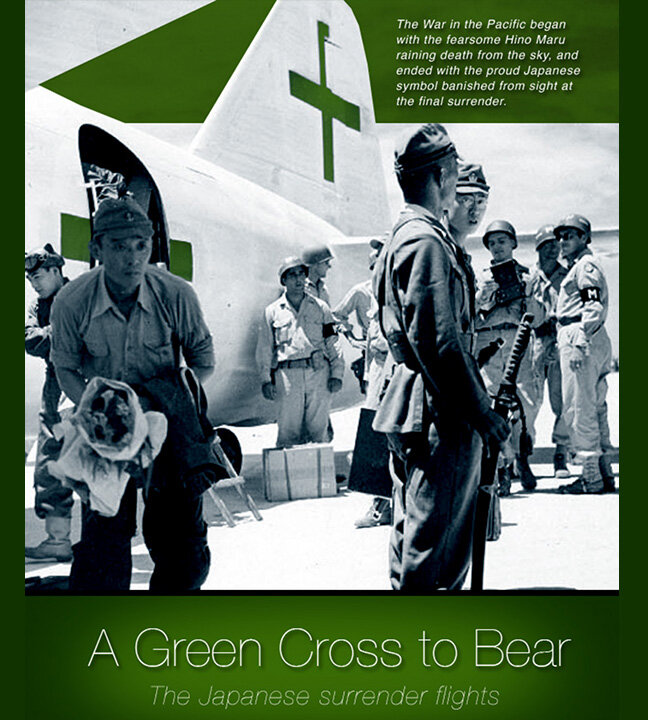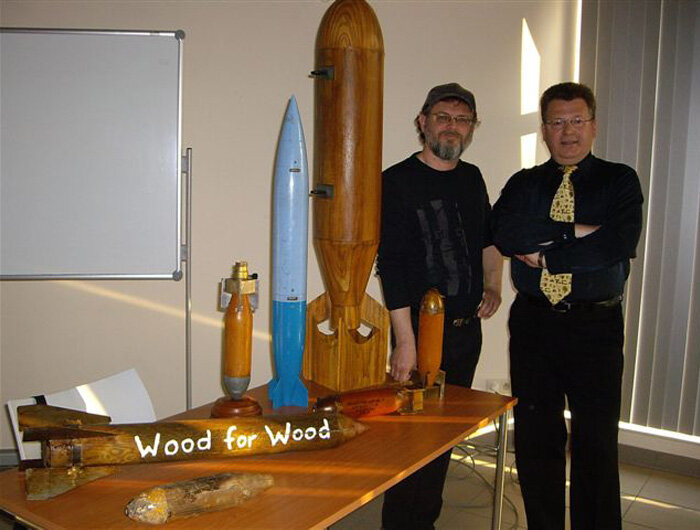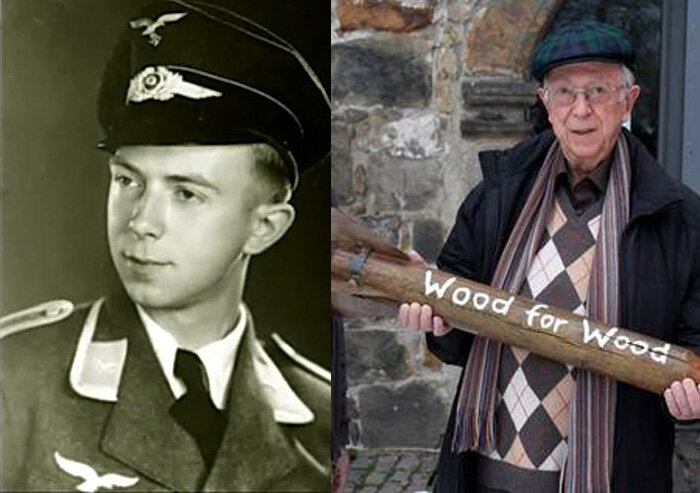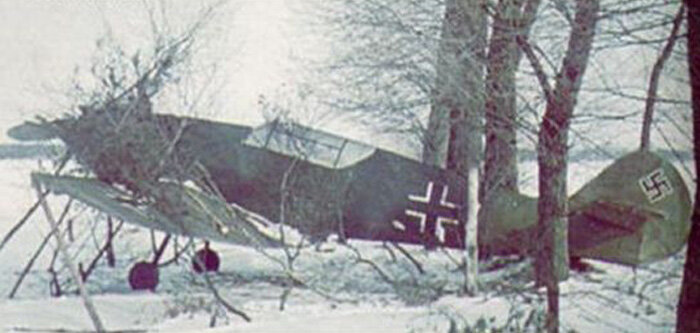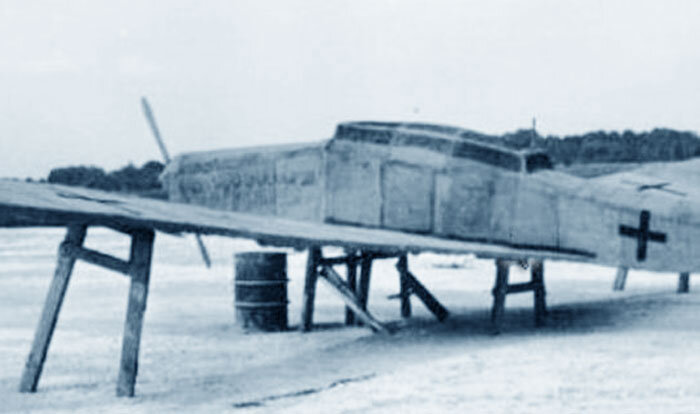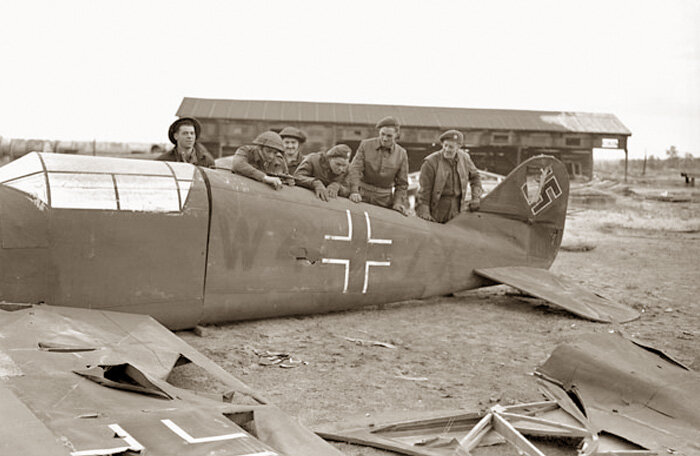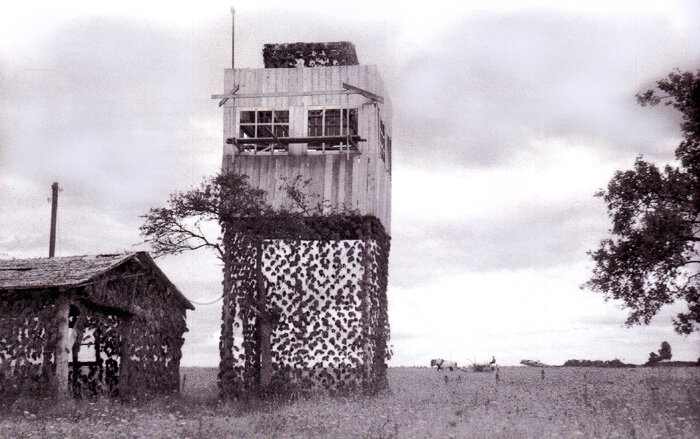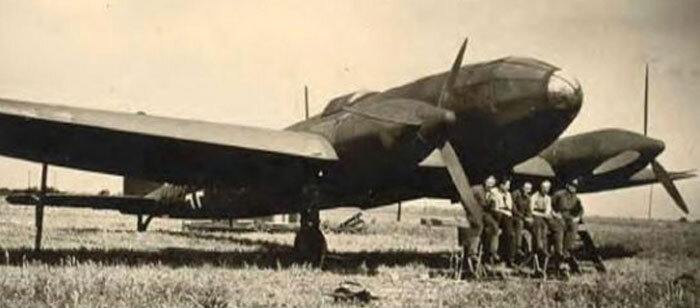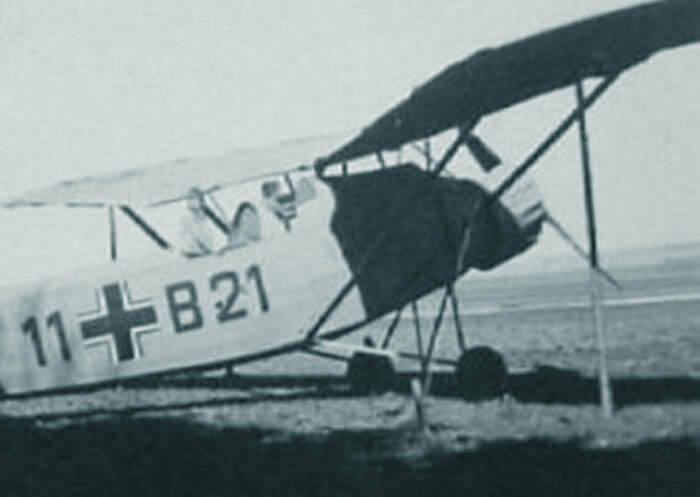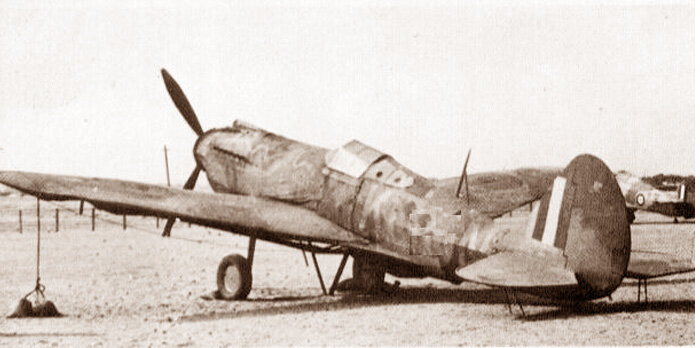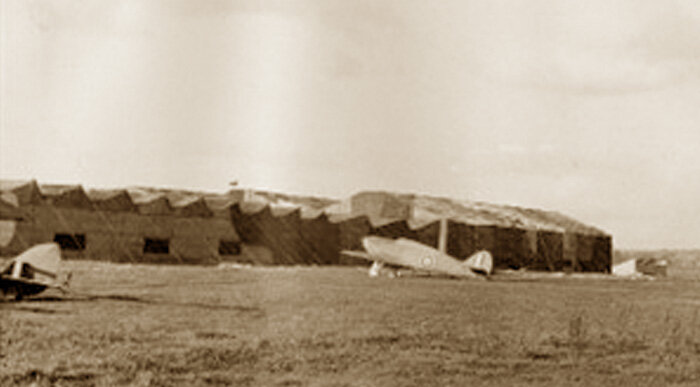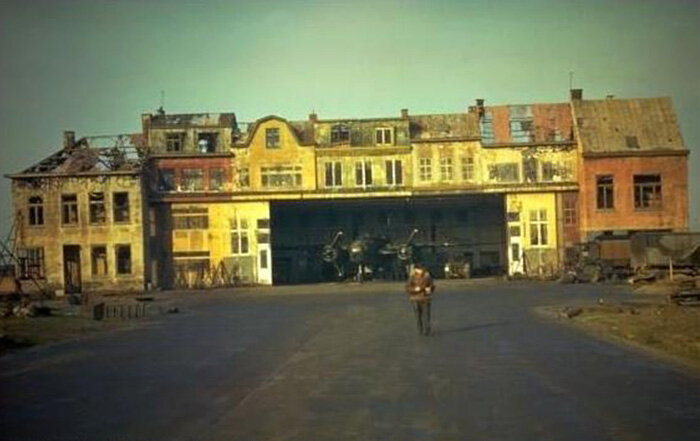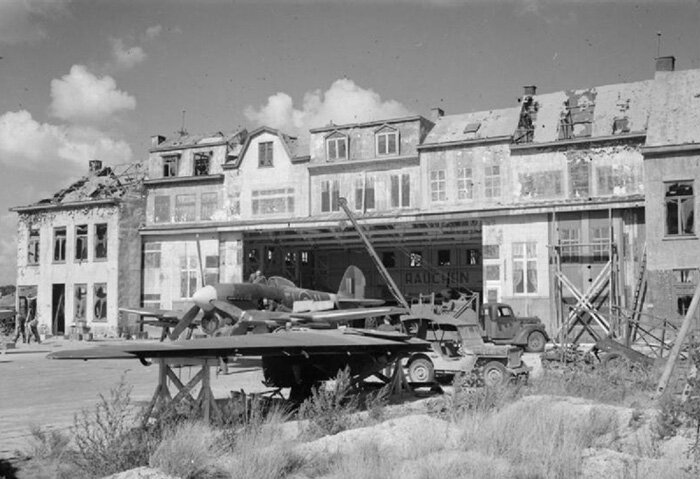WOOD FOR WOOD
French author Pierre-Antoine Courable and his Belgian cohort Jean Dewaerheid have brought the force of serious research to the seven decade-old legend of Allied bomber crews hitting fake German airfields with fake British bombs. Now, they are looking for former Commonwealth airmen who might have been party to the shenanigans which have become urban legend.
In what could easily be the finest and boldest example of death-defying and cheeky nose-thumbing during the Second World War or any conflict for that matter, bomber and intruder crews of the Royal Air Force and USAAF are reputed to have bombed the Luftwaffe's decoy airfields and dummy aircraft, not with high explosives or incendiaries, but with nothing more than dummy bombs made of wood, and painted with the smug remark “Wood for Wood”... all just to make a point.
Throughout all theatres of war, during the Second World War, from China to Holland to Kent, air forces, phsy-ops units and logistics people constructed dummy targets such as airfields, factories, truck parks, convoys and even ships, out of wood, canvas, burlap, or inflatable rubber. The decoy airfields were often populated with dummy aircraft and vehicles of such high quality, that even low flying recce aircraft with photographic equipment would have hard time telling the difference between the dummies and the real thing. The decoy airfields and dummy aircraft served several purposes simultaneously. They confused snooping enemy aircraft and hence planners as to the number of aircraft available to the opposing forces as well as to their displacement. They provided decoy targets for enemy bombers which, if attacked would prevent real aircraft from being destroyed. Often, these airfields were built near real airports in the path of attacking aircraft in the hopes that they would then drop their bombs and strafe the dummies, thereby saving the real aircraft.
If a decoy target did indeed induce attackers to drop their ordnance ineffectively, those that created the decoy would have certainly worn smug looks afterward... perhaps the deception would have been the source of much hilarity that night in the pub or brasserie. If the attackers later learned that they had been duped, they would have felt foolish indeed. So, if a dummy airfield was detected through spies or recce photography, it made sense to simply avoid it favour of the real target or to ignore it, leading the enemy to continue the ruse and waste the energies of Luftwaffe personnel. That would make sense for war planners and decision makers far from the daily meat grinder that was the war. For weary and frustrated pilots and aircrews, a chance to mock the efforts of their enemies, to make a point about who was winning, to complete a “skit” that would be the source of pride, soaring morale and back-slapping camaraderie from pub crawls to the fifty-year reunions of the future, seems to have been too good to pass up.
Imagine if you will.
You are standing along the edge of a large open field in Belgium, which, over the past three weeks, you and your fellow Luftwaffe airmen have laboured and transformed into a decoy airfield. You are on edge yourself. Two days ago, an RAF Mustang had made a low level pass right over the heart of the field. Everyone could see the round camera window on the side of the aircraft. Everyone knew he had seen.
Just as you finish pushing a massive wooden Ju-87 Stuka tail first into the surrounding forest, you hear the sound of approaching aircraft. An obergetfreiter next to you shouts Achtung!! Mücken!!! You look to the south of the field and see a pair of dark Mosquito fighter-bombers arcing in from the west. You and your pals run headlong into the wooded periphery of the airfield as the two wraiths thunder in. Your heart is racing – out of fear for your life and out of joy that you have tricked the bloody British or Canadians, or whom ever, into believing this was a real field. You can hear the whoops and cheers of your mates who also realize this at the same time.
Hiding behind a large tree, you peer out through the branched and catch a glimpse of the side of the fast moving pair, their bomb doors open, ripping down the far edge of the field where six Stuka replicas sit parked, tails in the forest. You smile… “Stupid Brits!”, you think, “We fooled you”. You watch from half a kilometer away as several oddly slender bombs drop away from the two Mosquitoes and tumble weirdly to the ground. Instinctively, you flinch from the impending explosion, withdrawing behind the tree. But there is nothing. Maybe there was a sound… but it was not an explosion. It sounded like a series of heavy thumps.
You look around to your friends. Everyone shrugs. After a few minutes, you see other airmen across the field walking near where the bombs were dropped. You cross the field to where several men are standing. One feldwebel is holding one of the bombs. Warily you look it over. It is not made out of metal. In fact it is simply a four foot length of wood… a log with the remains of four crude wooden fins at one end and a sharp end that reminds you of a pencil. There is writing down one side… “Wood for Wood”. The English-speaking sergeant translates “Holtz für holtz”. For a moment everyone lets this soak in. Soon they are all laughing and so are you. But as they chuckle away and collect the other logs, you realize something. All your work has been for naught. The English, they are on to you. Above all… you have a nagging thought which, for the first time, begins to gnaw away at the far reaches of your mind – you cannot possibly win this war.
The story of the wooden bombs, a legend that just won't die, has long been held to be true by unspecified witnesses and often retold through here-say and third hand accounts. Many "show-me-the-proof” historians have disdainfully discounted the legend as apocryphal, unsubstantiated poppycock and urban legend. The multitudinous aviation forums are battlegrounds where defensive-sounding “believers” duke it out with self-appointed historians who cannot believe a story unless it is written down in pilots' log books, Squadron ORBs, Wing diaries or found in the archives of the Imperial War Museum. The would-be nay-sayers of this former urban legend cite primarily the idea that it would be better to not tip off your opponent to the fact that you know about the phony airfield by dropping fake bombs on it. They state that somehow this would compromise your intelligence network on the ground and tell the enemy how much you know. But, I say, it would have much the same result if you were seen to overfly the airfield with recce aircraft and then never return with real bombs. Either way, the enemy knows you know. By dropping fake bombs on an fake and usually undefended mock-up of an airfield, you simply made the Germans look and feel foolish, your pilots and navigators flew a milk run and had a laugh and a skit and in the end you simply gained the upper hand. I for one have no trouble believing this, especially after reading the recently published book, Wood for Wood - the Riddle of the Wooden Bombs by Pierre-Antoine Courouble.
Many of Courable's detractors said that no squadron commander would ever have risked his pilots or his aircraft in such a misadaventure. Derwaerheid and Courable fired back that it was possible that squadron commanders might not have known about the antics of their pilots or may have turned a blind eye if the bombing of dummy airfields was combined with a real mission elsewhere.
To demonstrate this, they cite the well-documented instance of the Skyraider Toilet Bomb. In October 1965, Commander Clarence W. Stoddard, Jr., Executive Officer of VA-25 "Fist of the Fleet", flying an A-1H Skyraider, nicknamed "Paper Tiger II" from Carrier Air Wing Two aboard USS Midway carried a special bomb to the North Vietnamese in commemoration of the 6-millionth pound of ordnance dropped.
This bomb was unique because of the type... it was a toilet! The toilet was a damaged unit, which was going to be thrown overboard. A squadron plane captain rescued it and the ordnance crew made a rack, tail fins and nose fuse for it. Air Wing Two deck handlers maintained a position to block the view of the air boss and the Captain while the aircraft was taxiing forward. Just as it was being shot off the perpetrators got a message from the bridge, "What the hell was on 572's right wing?" There were many jokes with air intelligence about germ warfare, but the aircraft was allowed to continue, drop its real ordnance as well as its bit of toilet humour. The story of the flight was celebrated over the years in stories, paintings and models.
Related Stories
Click on image
French citizen and researcher Pierre-Antoine Courouble had one source for his belief in this story of British humour and derring-do - one that did not have a written record, was not found noted on a squadron ORB or pulled from the shelf of a musty archive. It was the strong and honest voice of his father, a man he loved and trusted. Here is what Courable says about the first time he heard the story:
“The first time I heard about the famous "legend" of the wooden bombs was during the summer of 1973. I can still picture the scene. My father was driving the family Citroën GS and we were going from Lesquin to Templeuve where what was to become our family home was being built. I was born in Lesquin, at No.1 of rue Sadi Carnot, the very street in which the Germans had requisitioned the neighbouring houses to lodge Luftwaffe pilots, one of whom was Joseph Priller, the Luftwaffe ace with 101 victims to his credit. I had spent my childhood with the noise of the engines from the neighbouring airfield in the background. A fan of anything to do with flying, I was fascinated by the stories about World War II. We had just passed the trees by the Fretin Fort when my father told me a story he had never mentioned before.
"Do you know that not far from this road the Jerries installed wooden planes?"
"No, I didn't, and why wooden planes?" I asked him.
"To make the Allies believe that they still had planes when they hadn't got any left!"
"I see. I suppose they also used them to deceive the enemy into bombing false targets," I replied in a knowledgeable tone to prove to my father that I knew something about military subjects.
"Yes, but it didn't work! The deceiver was out-done. The only bombs that the English dropped on those wooden planes were wooden ones! And they'd painted 'Wood for wood' on them!
I was fascinated by this tale. My father said that he had got the details of the story from Mr Cardon, a farmer in Lesquin, who had actually seen this amusing example of nose thumbing.
That is how he came to hear of this "great story"”.
Jean-Antoine Courable (right) and Belgian Jean Dewaerheid stand next to a collection of dummy aerial bombs - some real, some reconstructions. Courable researched the touchy subject over a period of two years and Dewaerheid translated the resulting book in to Dutch
In 2009, Courable published his book which, for this writer, finally proves with absolutely thorough research and the first-hand accounts witnesses that everyone said never existed that the wooden bombs for wooden targets skit actually happened.. and many times. A year later, the long-sought star witness for Courable's thesis, a Luftwaffe pilot by the name of Oberstleutnant Werner Thiel came forward and was video-taped corroborating the story of the Allied air force's joke.
Thiel was born in Dillenburg in 1923, and became Leutnant pilot in the Luftwaffe in 1943. He was detached at the Luftkriegschule Werder (An aerial warfare school near Potsdam) where he was the witness to the the dropping of a dozen dummy wooden bombs on fake wooden airplanes deployed there by his Luftwaffe. The bombs were marked with the painted words “Wood for wood”! This extraordinary testimony from a German officer was video-taped on 28th December 2010 by Pierre-Antoine Courouble. Here is a remarkable extract from that interview
Werner Thiel: I was born on the 24th of August 1923 in Dillenburg, in the center of Germany. I joined the Luftwaffe in 1942. After training courses in France (first in Romorantin, then Angers and later Le Mans) I was posted in October 1943 at the airfield of Werder, near Berlin. In those days I also worked at the false aerodrome of Borkheide that was equipped with a runway. We were living in a kind of container, nearby two air-raid shelters. These were in fact small bunkers where we could find refuge when the Allies bombed Berlin. At the end of October 1943, the air raid warning alarm went off. We put the lights on from the false runway and moved the decoy planes.
Courouble: How many decoy airplanes did you use?
Thiel: Maximum ten, I would say. They were made of wood and netting. A few nights before, we noticed reconnaissance missions, so we were prepared for the raid. We heard the planes coming …
Courouble: Sorry to interrupt you once again, but how many people were in charge at this dummy airfield?
Thiel: I would say a dozen soldiers. Not more.
Thiel: ... Like everybody else, we were afraid of these air raids. We heard the planes flying above us but this time nothing happened. At dawn, we left our shelter with cautious steps. We dreaded time bombs. We didn’t believe what we saw: they bombed us with wooden bombs! Six to ten wooden bombs laid on the ground, all with painted in white « Wood for Wood ».
Courouble: What about the body of those bombs? Was it hollow?
Thiel: They were made of solid wood. One of us was a carpenter and managed to use this excellent wood material to build new frames for the enlarged aerial pictures that were going to decorate our austere surroundings.
Courouble: Did you use all these bombs for that purpose?
Thiel: Yes, all of them. We were not the only guardsmen. Our colleagues were full of admiration and we exchanged some of our pictures for cigarettes or food …
Courouble: Do you remember what you thought at that time? Did you have any idea about the use of these wooden bombs?
Thiel: We thought it was meant as a joke. Something like “Look how stupid you are. You built a dummy airfield. We saw it and it’s not worth dropping a real bomb!”
(Thiel takes his glass and looks at the camera)
Thiel: I drink to the health of all pilots in the world and more particularly to the American colleagues. I would be extremely happy to meet one day the American pilot who dropped those wooden bombs. Prosit!
Young Leutnant Werner Thiel (left) around the time he witnessed the legend in the making and a photograph of of him in 2010 holding a mock-up of the bombs he saw lying on the airfield at Luftkriegschule Werder in 1943 after the night's air raid.
Sadly, this year Werner Thiel passed away in Germany, but his account as a Luftwaffe pilot who worked on one of the German dummy airfields and witnessed the wooden destruction of wooden aircraft, proves that Courable's thesis is correct - Bomber Command and then Eighth Air Force crews made mockery of the Luftwaffe's efforts to fool them by dropping wooden bombs on wooden airplanes.
Though Courable's book is published and though Theil's testimony puts to rest the legend of the wooden bombs, he and Dewaerheid are still looking for witnesses and in particular any allied aircrew or ground crew who might have participated in these “attacks”. The two know that time is running out to find men who flew these missions or who built the wooden bombs or “armed” the aircraft and would appreciate any eye-witness accounts to help build a permanent and comprehensive archive of this particularly humourous part of the history of the Second World War.
“Attrappen” — German Dummy Aircraft
A group of Luftwaffe ground personnel manhandle the fake wheel leg and pant into place beneath a wooden dummy Junkers Ju-87 Stuka propped up on oil drums somewhere in Western Europe during the war. The Germans, like their Allied opponents, built many dummy airfields across Europe and populated them with wooden and cloth aircraft of various detail, called “Attrappen”. The dummy Stuka in this photo looks like it has been moved many times as witnessed by the damage to the cloth covering of the wheel pant. In the background we see another dummy aircraft making up a bogus flight line of aircraft pressed beneath the cover of perimeter trees.
Given the trees, wheels and clothing (boots), this looks to be another photo of the same repositioning of a dummy Stuka at a dummy airfield as depicted in the previous photograph.
This photo of a dummy Stuka seems that it might have been taken at the same time or perhaps the same airfield as the two previous images, but after the canopy and fake propeller were installed. It is clear from shots like these that recce photo interpreters would have their work cut out for them in determining whether they were looking at real or fake aircraft in some airfields. They would be looking them over for other clues - tire tracks, personnel, structures.
A rather well done dummy Messerschmitt Bf 109 is pushed into the trees surrounding a fake airfield to simulate an attempt to hide the fighter from Allied aircraft. Saplings are even leaned against the wings to create this effect. Allied airmen coming across a neat row of enemy fighter aircraft sitting out in the open would be immediately suspicious of a dummy target. Some dummy airfields had staff to move aircraft around to portray a different operational look each day, thus simulating a real target. Even taxiing aircraft were simulated with towing cables and trolleys.
Not 100% sure here, but this dummy Messerschmitt sits atop a trolly for towing to simulate a taxiing fighter.
This really crude interpretation of an ersatz Luftwaffe fighter made is with canvas and wood and supported by trestles.
Soldiers of the Royal Canadian Army Service Corps (R.C.A.S.C.), 4th Canadian Armoured Division, examining a dummy German aircraft, Huijbergen, Netherlands, 28 October 1944.
The same group of Canadian soldiers inspect the front end of the bogus aircraft. The Corporal on the right seems to have torn the swastika-adorned fabric from the tail of the aircraft as a war trophy.
Dummy airfields needed dummy structures including a control tower like this one in France.
Whether this was built to simulate a Dornier Do-17 or a Junkers Ju-88, I am not certain as the tail looks unfinished. A Luftwaffe airman adjusts the support for the engine nacelles.
A rather poor quality shot of a very believable dummy Messerschmitt Bf-109
This well proportioned dummy Heinkel 111 looks to be freshly installed - perhaps by the very men photographed with it.
Another fine example of a fake Heinkel 111 from a different manufacturer/carpenter.
First set the trap, then wait for someone to notice. A Luftwaffe officer makes a show of looking for Allied bombers and fighters as he hopes to lure them into dropping their payloads on his rather sad dummy Heinkel 111.
An extremely elaborate skeleton for a canvas and frame Messerschmitt 410 prior to getting wrapped in canvas. It appears that highly skilled cabinet makers or carpenters and weeks of time were employed to create this one.
A pair of phoney Focke Wulf 190 fighters sitting at the edge of this German airfield are caught by a low flying recce aircraft. The fighters were moved to the edge of the field to simulate the practice of pushing real aircraft into the protective camouflage of surrounding woods.
Another pair of fake Focke Wulf 190s have either done their job and have drawn the fire of Allied aircraft, or are simply smashed when moved by Allied troops after the field was captured. I suspect the latter.
American soldiers ride up on a farmer's field which is the site of another phoney German airfield populated by a squadron of faux Junkers Ju-88s
In order to fool the most jaded photo interpreter, the Luftwaffe included many lesser types in its faux inventory including this concoction which seems to resemble a Henschel Hs 126 liaison aircraft. It appears as if the ruse was taken all the way to creating the two man crew in their cockpits.
Another example of a dummy Junkers Ju-88 medium bomber with a poor interpretation of the glass cockpit and bombardier's position.
I am not sure what service or country this gentlemen is from, but I suspect it might be a British soldier or paratrooper posing with a derelict dummy fighter - possible meant to be a Messerschmitt Bf 108 Taifun or Bf 109.
This Luftwaffe decoy aircraft is at the very low end of the quality and believability spectrum. Basically just a flat surface painted to appear in three dimensions and suitable only for fooling higher flying non recce aircraft.
The Germans knew full well that Allied recce aircraft would be out in full force ahead of bombers and fighters looking for V-1 “Buzz Bomb” launch sites. The sustained “Doodlebug” campaign saw more than 9,500 V-1s launched at London and surrounding areas, peaking at more 100 attacks per day. Here a pair of RAF airmen inspect a dummy V-1 in its cradle - with a unique shark's mouth paint job.
Decoy Aircraft of Other Nations
The science and art of camouflaging targets such as airfields to hide from prying eyes or, as in the case of the Wood for Wood story, to make them seen, believed and attacked by the enemy has existed as long as there has been warfare. The practice was utilized by all sides during the Second World War to sow disinformation, to hide value targets and to trick the enemy into committing assets and expending expensive ordinance in a fruitless attack on a piece of folk art. The most important part of creating a ruse such as a decoy airfield was the manufacture and deployment of decoy aircraft. These decoys had to be good enough to elicit a response such as an immediate attack by marauding intruders, or to convince battle planners who relied on photo interpretation that this was a target of high value, worthy of attack.
The degree to which this practice was carried out varies. Many dummy aircraft were simply constructed by local labour–crude and functioning at the basest of levels–while some were so believable as to guarantee attack if discovered. It seems that there are not many photos of these faux aircraft that survive today. Most are poor quality digital images, with the best having been taken by victorious ground forces after overrunning the fields where the aircraft were. After reading “Wood for Wood”, I spent some time on the web researching and grabbing images where I could. What follows is an album of images of dummy/decoy aircraft which shows the efforts taken by all sides.
This rather thinly disguised dummy RAF Hurricane was was designed to fool high flying intruders with a basic top plan and shadow.
How to take the world's most beautiful airplane and make it look like a dog. Two canvas over frame Spitfires adorn a bogus airfield in England. It was important that each aircraft have a shadow to convince Nazi photo interpreters that the aircraft were indeed real. To that end, the Spits are elevated on spindly poles. Even the propeller doubles as an elevating device.
Another canvas and frame Spitfire shows the quality of this decoy - including semi-gloss paint, flap, aileron and canopy lines. It appears that this one was manufactured to a standard in a factory and is much like the those in the previous photo.
This is a British photograph of Douglas Boston on an airfield in England prior to the D-Day landings. Dummy aircraft were used to populate airfields farther afield from the buildup of equipment near the real jumping off point for the invasion. This was done to keep the Germans guessing as to the whereabouts of the ultimate location of the certain assault. This smaller-than-100% scale Boston sports an additional wheel at the back to support the structure which would have a much more aft centre of gravity without the weight of engines.
Another well-constructed dummy of a Douglas Boston with what appear to be wooden wheels, is being “serviced” by a camouflaged fuel bowser. This quality dummy appears to have come from a manufacturing facility tasked with the creation.
Dummy Ilmavoimat (Finnish Air Force) Hurricane built for a fake airfield in the summer of 1940. The dummy aircraft was constructed from wood, canvas and paint and was designed to look completely realistic from the air. The Soviet Air Force wasted some 80% of their attacks on Ilmavoimat airfields on such dummy targets. There were no reports of Soviets dropping fake wooden bombs on Finnish airfields. The image has been censored by the removal of the Finnish swastika from the fuselage.
A Curtiss P-40 Warhawk decoy under construction at a base somewhere in China Burma India theatre. This detailed decoy has been constructed of wood; two men can be seen working on the left side of the fuselage. SI 90-13683, Smithsonian National Air and Space Museum Archives.
This dummy US Army Air Force P-51B at Gosselies Airfield, Belgium, in 1945 was made of painted canvas on a wooden frame. Showing invasion stripes, it was clearly made after the D-Day invasions at Normandy.
A dummy plane, made of lath and burlap or canvas, is parked a good distance from hidden hangers to decoy bombers, fool enemy observation ships. From the air, this is practically indistinguishable from a real plane, but up close, it looks like it was built by children.
A dummy Lockheed P-38 Lightning built to sucker Japanese navy fighters in the Aleutians.
The RAF erected massive tents to act like airfield hangars and maintenance facilities and parked dummy Hurricane aircraft outside to complete the ruse.
Looks like these American soldiers are putting the final paint touches on a US Army L-4 Grasshopper liaison spotter aircraft dummy.
Not all airfields were disguised to be seen
While, as we have seen, some forms of camouflage/disguise were designed to bring you in close and beg you to attack, others were created for the opposite reason - to be unnoticed, to be ordinary, to be anything but an important military target. Hangars became chateaus, maintenance buildings became town homes, and runways were cow pastures. What follows here is an album of the creative efforts of the Luftwaffe to disguise their actual airfields. While the phony airfields provoked the RAF intruder pilots to drop faux bombs on faux airfields, the following facilities, when discovered, received the real deal bombs.
The Germans went to extreme and elaborate ends to create the illusion of a French town where in fact there was a hangar filled with aircraft. Here, an Allied B-25 bomber occupies the space designed for Luftwaffe aircraft beneath a long row of faux French apartments. One can clearly see that this ruse would work on anyone snooping with a recce aircraft.
The same trompe d'oeil row house as the previous decoy at another time houses a Hawker Typhoon in for maintenance with a crane holding up its tail. Inside the we see the typical hangar admonition: Kein Rauchen - No Smoking
Another chateau come hangar after its capture by the Allies.
A German hangar disguised as a country home with faux windows, chimneys and even ivy growing up the side.
Of course, if you were going to disguise your airfield to look like the French chateau of a wealthy man in the province of Touraine, it would be best to have few chevaux trotting about the place for the benefit of the recce cameras. Of course, you couldn't have them there when your own aircraft were operational, so best to use inflatable ones. Note the cow in the background
Though not a target itself, the presence of a cow in a field could convince would-be attackers that the field that looked like a great place to fly aircraft from was in deed just a dairy farm.
The Decoy Aircraft Business is Still going Strong
Despite the excellent quality of satellite reconnaissance photography available to opposing forces today, high grade, inflatable dummy aircraft are still deemed effective and are being deployed in attempts to fool the enemy.
Inflatable F-16s line a fake flight line.
Russian technicians pump air into an inflatable rubber Sukhoi Su-27 fighter with ordnance slung on hard points beneath the wings.






